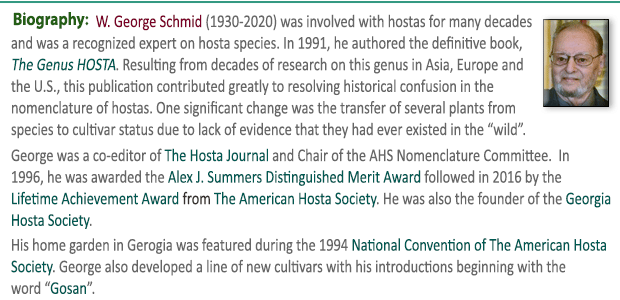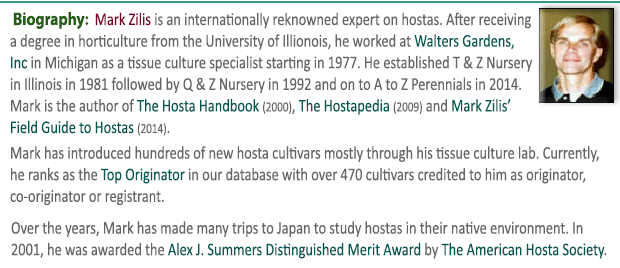|
 This species was first described
by
Dr. Fumio Maekawa in 1936.
They are of variable proportions between miniature and small size plants
and may grow up to 12 inches high by 31 inches wide under
cultivation. It has shiny
green, lance shaped leaves that have blunt bases. They bear
purple, funnel shaped flowers with purple anthers in September.
This species sets viable seeds. This species was first described
by
Dr. Fumio Maekawa in 1936.
They are of variable proportions between miniature and small size plants
and may grow up to 12 inches high by 31 inches wide under
cultivation. It has shiny
green, lance shaped leaves that have blunt bases. They bear
purple, funnel shaped flowers with purple anthers in September.
This species sets viable seeds.
 The Genus Hosta by W. George Schmid (1991), says that this species is known as the "small rock
hosta" in its native Japan. The species epithet, gracilis means gracefully slender
which refers to its long, slender flowers. H. gracillima
is sometimes confused with H. venusta "...but the flowering scape of H. gracillima is smooth
while that of H. venusta has ridges, and this difference
can serve as a positive identifier." The Genus Hosta by W. George Schmid (1991), says that this species is known as the "small rock
hosta" in its native Japan. The species epithet, gracilis means gracefully slender
which refers to its long, slender flowers. H. gracillima
is sometimes confused with H. venusta "...but the flowering scape of H. gracillima is smooth
while that of H. venusta has ridges, and this difference
can serve as a positive identifier."
 From the
Field Guide to Hostas by Mark Zilis (2014), "...offers a combination of a very dense mound habit, small
size, good growing habits, and late-blooming flowers. The latter
characteristic should not be overlooked because there are few
plants for the shade garden that bloom so late in the season." From the
Field Guide to Hostas by Mark Zilis (2014), "...offers a combination of a very dense mound habit, small
size, good growing habits, and late-blooming flowers. The latter
characteristic should not be overlooked because there are few
plants for the shade garden that bloom so late in the season."
The New Encyclopedia of Hostas by
Diana
Grenfell (2009) states in its Miniature Hostas chapter: "Site in light to
moderate shade at the front of a raised border with accompanying
small plants or, better still, in a dedicated border with other
mini hostas, such as blue-leaved H. 'Bill Dress's Blue' or the
green margined, yellow-centered H. 'Cracker Crumbs'. Just as
delightful grown as a single specimen in a container. The parent
of a number of other miniature hostas."
Mark Zilis' Field Guide to Hostas (2014)
states that this species was found in Japan on "...hillsides..."
 Nomenclature changes recommended in the
1991 book The
Genus Hosta by
W. George Schmid and accepted by The American Hosta Society would update names as follows:
H. tortifrons is now H.
'Tortifrons'
and H. tardiflora is H.
'Tardiflora'. Nomenclature changes recommended in the
1991 book The
Genus Hosta by
W. George Schmid and accepted by The American Hosta Society would update names as follows:
H. tortifrons is now H.
'Tortifrons'
and H. tardiflora is H.
'Tardiflora'.
Mikiko Lockwood in an article on The Hosta Library titled,
A Little About Japanese Hosta Terms defines the term iwa as rock, Iwa Gibōshi or
H. longipes.


An article about Fall Bloomers by
Herb Benedict and
Jim Wilkins in
The
Hosta Journal (1991 Vol. 22 No. 1) states that, "Here
are some of the fall blooming plants we grow...(listed in the order of bloom
times in Michigan).
| 1) H. kikutii
|
A medium size plant densely flowering
with white blooms. The flowers are equally arranged around the
central axis of the raceme so that the bloom scapes resembles a
bottle brush or pony tail...We are growing two named varieties,
'Hirao-59' and 'Finlandia'. |
| 2) H. 'Fall Bouquet' |
Small, green plant, leaves slightly
undulated, lavender scape and blooms, floriferous. |
| 3) H. longipes |
Small green plant, densely flowering
with a tall stiff bloom scape. The flowers are lavender and the
leaves are green. |
| 4) H. gracillima |
Funnel-shaped, light lavender flowers.
A miniature green plant, with shiny surface. |
| 5) H. 'Iwa' |
Iwa means rock, and this plant was
imported by Marjorie Soules, from Japan. It is a small green plant
with lavender flowers. |
| 6) H. tortifrons |
In the same section (Picnolepis) as
H. longipes and
H. rupifraga. Distinctive small plant, with twisted
green leaves and lavender flowers. |
| 7) H. 'Fused Veins' |
Small, green leaves often with ¼ inch
margin which is a lighter green. The lance shaped leaves are
undulated and the veins come together regularly. The flowers are
mauve and the scape is sometimes branched. |
| 8) H. rupifraga |
Small, medium green, with thick,
leathery, ovate leaves. Densely flowering with purple flowers. 'Urajiro',
'Grand Slam', 'Maruba Iwa' |
| 9) H. tardiflora |
This small hosta is the last to bloom
for us. Its leaves are shiny, dark green and lance shaped. The
flowers are light lavender and borne in abundance on 12 inch scapes. |
In answer to a question about growing smaller hostas that appeared in
The
Hosta Journal (2012 Vol. 43 No. 2),
W. George Schmid
of Georgia, author of
The Genus Hosta (1991) commented, "My favorite minis are
H. venusta,
H. gracillima, a white-margined sport of
H. gracillima named 'Kifukurin
Ko Mame', H. pulchella and 'Blue Mouse Ears' ."




|



